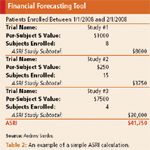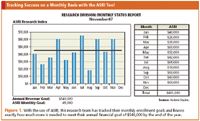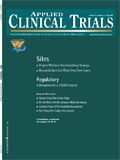A Dow Jones for Sites
Real-time financial performance indicator for clinical research sites that answers the question, how are we doing?
Clinical research sites across the country continue to struggle with managing their economic reality. Recent data indicates that many hard working clinical research sites are not operating on a financial break-even basis.1 Losing money may be a significant reason why many health care institutions and principal investigators are terminating their clinical research programs.

( Photography: Getty Images Illustration: Paul A. Belci)
Statistics show that for every two new physicians engaging in research practice this year, 1.5 will give it up within two years.2 According to the Tufts Center for the Study of Drug Development, the number of principal investigators conducting industry sponsored clinical studies in the United States has declined 11% since 2001. "By 2000, half of all principal investigators in the United States chose never to conduct another clinical trial—nearly double the turnover rate observed 10 years before."3
Compounding these challenges is the continued 20-year transition of clinical research projects into private medical practices. Nearly two-thirds of all studies are placed in community-based, for profit investigative sites.4 Private practices are unable and unwilling to sustain nonessential endeavors that continue to lose money. To ensure the perpetuity of clinical research programs, there is a need for diligent financial monitoring and reporting.

Table 1: These important measures do not help forecast future financial results.
Site measurements
The topic of financial reporting for clinical research sites is large and overwhelming. Principal investigators and their research team members become involved in research for various reasons, including scientific interest, access to state-of-the-art therapies, and a passion for improving patient care. Few of these research professionals decided to pursue clinical research purely for financial gain. This situation has resulted in a message frequently heard from sites across the country concerning the need for an economic measure of their current financial success.

Table 2: An example of a simple ASRI calculation.
Many sophisticated research sites develop complex annual budgets; however, this one-time process does not measure the ongoing success (or failure) of the research site. Stated in a different manner, research sites need a Dow-Jones indicator that evaluates their real-time performance. This site-based research indicator needs to be accurate, intuitive, useful, and easy to calculate. The purpose of this article is to share a research indicator that sites can use throughout the year to answer the important question posed by principal investigators and executive managers nationwide: "How are we doing?"
Let's consider the need for a real-time research performance indicator by reviewing the popular Dow Jones Index. The Dow Jones Index Average (DJIA) is one of the most widely followed financial indicators in the world. The DJIA appears in newspapers, throughout the day on TV, and in real-time on many financial and consumer Web sites. The DJIA represents a collection of 30 internationally recognized blue chip stocks. While there are many alternatives, the DJIA is still the index we instinctively check first to see how the market is doing.5 At any given point, there are approximately 10,000 stocks in the United States.6
The quantitative value of this relatively limited index of 30 companies is debatable. However, the relevance of the DJIA to most consumers is the correlative value and learned associated meaning. There is a correlation between the DJIA and the value of most retirement stock holdings. In other words, when the Dow Jones is up, many 401(k) mutual funds are also up. When the Dow is down significantly, it is understood that the value of most retirement holdings has been reduced. Investors and consumers have learned the association between the DJIA and many financial investments. Clinical research sites need a similar performance metric that can be easily reviewed on a regular basis.

Figure 1. With the use of ASRI, this research team has tracked their monthly enrollment goals and knows exactly how much more is needed to meet their annual financial goal of $540,000 by the end of the year.
Performance reporting
Clinical research sites need to make an important financial assessment and decision when reviewing new study opportunities and their respective budgets. The acceptance of a proposed trial budget represents a significant long-term investment decision. Comprehensive management of a clinical research program includes making the appropriate study selection decision; however, a site also needs to conduct consistent reviews of relevant ongoing performance measures.
Many advanced clinical research managers construct and regularly publish performance reports, status reports or key indicator reports. These important analyses are designed to investigate and evaluate the work completed by the clinical research team. Unfortunately, most of the key indicators included in these reports have limited correlative value with the long-term financial performance of research sites. These backward-looking indicators reflect the work completed at the site; they do not accurately forecast the future financial success of the research program. Table 1 includes a review of many commonly reported clinical research site status indicators.
Most commonly reported performance measures contain a review of historical work completed—many have no financial basis. These interesting and important data points are unable to assist the clinical research professional in forecasting the future financial results of their program. The limitations of these measures and the need for a more accurate metric have resulted in the development of a new performance indicator: the Andrew Snyder Research Index (ASRI). This research index is based on the latest management accounting and executive dashboard academic lessons.7 It is easily calculated and includes a blend of several commonly reported site performance measures.
The ASRI is defined as the contractual value of subjects enrolled. The value can be computed over any period of time. Here is the formula:
ASRI = Sum [Contractual Value Per Subject x Number of Subjects Enrolled]
ASRI builds upon the most commonly published status report metric (i.e., the number of subjects enrolled) to develop a financial forecast for your research program. It recognizes the successful enrollment of a subject as a future revenue stream. Regardless of the amount of work required or the length of subject participation, enrollment of a research subject represents the contractually and legally defined beginning of a future revenue opportunity. Upon enrollment, your research team will implement the clinical trial protocol with the subject. You will be financially compensated for this service according to the terms of the contract. The ASRI converts your success in enrolling subjects into a quantitative future revenue analysis.
Analyzing the sum of all future revenue opportunities will provide your research team with a useful financial forecasting tool. The example displayed in Table 2 provides a simple review of the ASRI calculation. This example demonstrates a research team that is managing three enrolling clinical trials. The contractual per subject value of the studies ranges between $250 and $7500. This research team split their efforts between the three trials and successfully enrolled 27 subjects.
Research index value
The ASRI provides a considerable amount of information to interested coordinators, site managers, principal investigators, and executive management. It also can be an accurate indicator of future revenue performance.
The ASRI normalizes many research data points into financial terms and provides a relevant assessment of revenue opportunity. It does not indicate precisely when the subject revenue will be recognized, but simply illustrates the relative value of all subjects enrolled. The ASRI is relatively accurate due to the inclusion of specific trial information and real-time enrollment values. It does not use rule-of-thumb study heuristics—the calculation relies upon your detailed study budget information and actual subject enrollment results. As a quick-and-easy financial forecasting tool, the ASRI provides a projection of research program revenue results.
One of the primary benefits of the DJIA is the correlative value of the financial indicator: as the Dow goes up, many retirement holdings are likely increasing in value. The strength of the ASRI is the correlation between it and the fiscal year-end revenue results experienced by research programs. By definition, as the ASRI increases, the revenue stream (and year-end financial results) will also increase. The ASRI is not a substitute for a thorough budgeting process. Moreover, it is most valuable when used in conjunction with a detailed enrollment forecast.
Here is an example of how it works. A research program's annual revenue goal may indicate that the research program must enroll subjects totaling $1.2 million in financial value while participating in a number of various trials. The ASRI would indicate that you must enroll $100,000 worth of subjects each month. If the ASRI result for one month is only $50,000, the site will immediately realize they are significantly behind schedule. The ASRI correlates very closely with the research programs ability to meet their financial goals.
The ASRI correlates directly with revenue forecasts; however, it can also be compared to research program expenses. For many clinical research teams, fixed expenses may represent 80% to 90% of their total annual expenses. Expense categories such as salary support, rent, and overhead do not change with enrollment results. Research sponsors provide most of the study's medical, clinical, and administrative supplies. As such, the variable expenses typically represent a relatively small fraction of the research program's annual budget.1 Following this logic, the ASRI can provide the site manager with a quick and easy profitability indicator.
Consider the following example. A research site forecasts $550,000 of annual fixed expenses for staffing, overhead, etc., and another $50,000 of variable expenses for hospital procedures for a total projected expense budget of $600,000. In this example, the site needs to enroll at a financial rate of $50,000 per month in order to break even. If the site only enrolls $25,000 worth of patients in a particular month, they will have to make up the difference in the following month in order to maintain pace with their expenses.
Data sharing
For site managers, the most important characteristic of the ASRI analysis tool is its ability to intuitively convey a complex amount of information to a wide variety of interested stakeholders. The ASRI performance metric can provide principal investigators, executive management, and research team members with an assessment of their long-term performance. A monthly status report may contain many relevant metrics, but physician stakeholders appreciate the value of this Dow Jones-like research indicator and its statistical correlation with their research program's financial success. Additionally, this data point is reported by some of the more advanced clinical trial management systems; in this case, the ASRI is immediately available at anytime.
Figure 1 provides an example of a research program with an annual budget of $540,000. This research team needs to enroll at a rate of $45,000 worth of patients per month in order to meet the financial goal. This example illustrates a fairly typical research team that has experienced several months of busy enrollment and a few months in which their enrollment efforts were less productive. In either case, this research team is tracking their success on a monthly basis against their stated goal ($45,000 of enrollment value per month). This evaluation process provides the research program with a tool to make strategic decisions based on quantitative performance data. As you can see, the research site needs to enroll at a higher rate in December to meet their financial goals. The site can monitor the trend of the research index and make operational changes throughout the year. If the research index is below budget, the site could shift staff between studies and pursue financially viable trials with a positive enrollment trend.
The ASRI combines several types of information into one performance metric. This status measure normalizes data that might otherwise confuse the issue. It doesn't matter how long studies run, it doesn't matter how many subjects are enrolled in any particular study or even that a favored study closed early. Research sites recognize the reality that clinical research is a volume-based industry. To remain financially viable, sites need to consistently enroll patients over the long term. The ASRI is designed to measure this enrollment success and provide research centers with real-time information to make important staffing, study selection, and strategic decisions.
Limitations
The ASRI is a performance indicator designed to evaluate the long-term performance of clinical research team activities. It cannot be directly converted to revenue or cash budget forecasts. Remember the Dow Jones. You cannot link the DJIA performance directly to your financial worth. The DJIA is simply an indicator of the financial market's direction.
The ASRI is an indicator of research program enrollment and revenue direction. It is a pure financial performance metric. This financial measure does not evaluate the work required to complete the enrollment and provide care for your research subjects. It also does not allow for subjects that withdraw or discontinue. Sites that participate in studies with high drop out rates need to adjust their ASRI goals accordingly.
Conclusion
Clinical research sites continue to struggle with the financial pressures associated with managing clinical research protocols. Sophisticated clinical research sites are able to develop annual research budgets; however, there is a need for an easily calculated financial performance indicator that illustrates and forecasts the research site's economic performance. The ASRI is an accurate, correlative, and comparative status metric that combines financial information and enrollment results to provide intuitive information to research stakeholders. Consistent utilization of the ASRI will assist research teams in managing their strategic goals and answering the question: How are we doing?
Andrew Snyder, MBA, FACMPE, is a faculty member at Metropolitan State University and director of research finance at the St. Paul Heart Clinic, 225 N. Smith Avenue, Suite 500, St. Paul, MN 55102, email: asnyder@stphc.com
References
1. A. Snyder, "Clinical Research; Value to the Medical Practice and Identification of Best Practices," American College of Medical Practice Executives—Medical Group Management Association, August 2004.
2. W. Henderson, "Clinical Research in the Private Medical Practice," American College of Medical Practice Executives—Medical Group Management Association, September 2002.
3. Tufts Center for the Study of Drug Development, "Number of Principal Investigators in the U.S. is Declining," www.csdd.tufts.edu/newsevents/recentnews.asp?newsid=54.
4. K. Getz, "Industry Trials Poised to Win Back Academia," Applied Clinical Trials, April 2007, 35-38.
5. Dow Jones Indexes, "Key Benefits," www.djindexes.com/mdsidx/index.cfm?event=showAvgBenefits.
6. J. Zweig, "How Many Stocks Should You Own?" CNN Money, www.money.cnn.com/2007/09/06/pf/zweig_september.moneymag/index.htm.
7. R. Kaplan and N. Inamdar, "Applying the Balanced Scorecard in Healthcare Provider Organizations," Journal of Healthcare Management, 47 (3) May-June (2002).

Improving Relationships and Diversifying the Site Selection Process
April 17th 2025In this episode of the Applied Clinical Trials Podcast, Liz Beatty, co-founder and chief strategy officer, Inato, discusses a number of topics around site engagement including community-based sites, the role of technology in improving site/sponsor relationships, how increased operational costs are impacting the industry, and more.
SCOPE Summit 2025: Enhancing the Patient Experience Through Site Centricity
February 12th 2025In an interview with ACT senior editor Andy Studna at SCOPE Summit, Ashley Davidson, vice president, product lead - sponsor tech strategy, Advarra, highlights the need for more site-centric approaches in study startup.